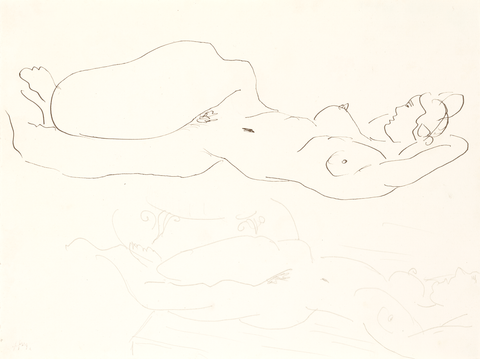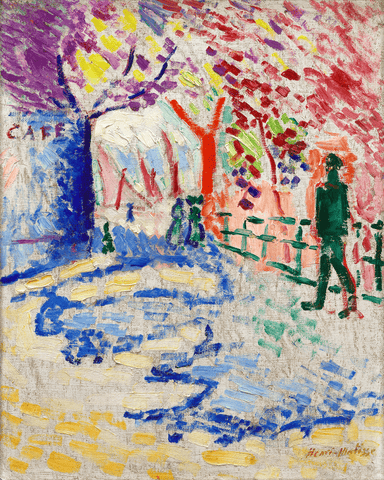Artists & Artisans
Matisse, Henri
Widely regarded as one of the most important and celebrated artists of the 20th century, Henri Matisse was a luminary creative at the frontlines of modern art’s most significant movements. He was a draftsman, printmaker and sculptor, but is best known as a painter. Although Matisse was initially labeled a member of the Fauvist movement, by the 1920s he was increasingly hailed as an upholder of the classical tradition in French painting. His mastery of the language of color, expression and drawing, as displayed in his oeuvre spanning over a half-century, solidified his place as one of the few true revolutionaries of 20th-century art.
Upbringing
Matisse was born in 1869 to a prosperous family. His parents, successful flower business owners, had grand ambitions for his future. In an attempt to meet his parents’ expectations, Matisse, much like his contemporary Pierre Bonnard, began his career as a lawyer. At the age of 22, he fell ill with appendicitis and was bedridden for two months. During his recovery, his mom gave him a set of oil paints to help keep him entertained. This serendipitous gift monumentally changed the trajectory of Matisse’s life.
Education
Intent on pursuing a career in art, Matisse sought admission at the École Quentin-Latour, the most prestigious art school in Paris. After failing his entrance exams in 1892, he devised a plan to wait outside the school’s entrance so he could “bump” into one of the tutors and show them his paintings. After doing this for a few weeks, Matisse was eventually invited inside to audit a few classes. After failing his 1894 entrance exams as well, Matisse only further devoted himself to his studies. Finally, in 1895, Matisse was accepted to the school and thus began his formal art education.
Although Matisse was undeniably dedicated to his studies, his early art was critically received as bland. It was not until 1890 when he bought The Three Bathers by Paul Cezanne, the famed painter who Matisse called “the God of painting,” that Matisse began exploring diverse colors and a painterly style. Matisse’s evolving style echoed the groundbreaking work of Paul Gauguin, who similarly broke away from traditional techniques to embrace expressive forms, vivid palettes, and emotionally charged compositions.
Career
In 1905, Matisse’s work entered a new stage of creative exploration when he linked up with the free-spirited artists Albert Marquet and Georges Rouault. Whereas Matisse’s family considered these men unruly drunkards and drug addicts, Matisse found in them a kindred spirit. Together, these artists created Fauvism, deriving from the French word fauves, meaning “wild beasts”. Fauvism was a radical movement of loosely connected artists who above all championed the separation of color from its traditional, natural forms. Instead, they used vivid hues to convey the emotional state of the artist, as well as the psychological impact of a scene. These artists created flattened, simplified scenes filled with highly saturated color in order to convey a strong and immediate visual impact. Led by Henri Matisse, the group also included Maurice de Vlaminck, Kees van Dongen and Raoul Dufy.
Later Work
Throughout his six-decade career, Matisse was both consistently and astoundingly prolific. In his later years, Matisse spent the majority of his time bedridden. Although his body was slowing down, Matisse’s artistic vision was just reaching its zenith of innovation and exploration. With a pair of scissors and bits of paper, Matisse constructed large collages that remain some of the greatest ever produced in the medium.
Legacy
Matisse was renowned throughout his career for his versatility as an artist, and his vast body of work encompasses painting, drawing, sculpture, graphic arts, paper cutouts, and book illustration. Perhaps one of art history's greatest draftsmen, he is today considered among the most influential artists of his era alongside Pablo Picasso, who was both a close confidante and friendly rival. His ability to see beauty in simplicity set him apart from his contemporaries, and paved the way for the Abstract Expressionists, Minimalists and Pop artists who followed him. Still relevant today, his body of work continues to form the basis of retrospectives and exhibitions at important museums worldwide, including the Metropolitan Museum of Art in New York, Tate Modern in London, and the Museum of Fine Arts in Boston. Rare and artistically significant, this extraordinary pencil work is an undeniable treasure from one of the very best artists of the modern age.
Artists & Artisans
Matisse, Henri
Widely regarded as one of the most important and celebrated artists of the 20th century, Henri Matisse was a luminary creative at the frontlines of modern art’s most significant movements. He was a draftsman, printmaker and sculptor, but is best known as a painter. Although Matisse was initially labeled a member of the Fauvist movement, by the 1920s he was increasingly hailed as an upholder of the classical tradition in French painting. His mastery of the language of color, expression and drawing, as displayed in his oeuvre spanning over a half-century, solidified his place as one of the few true revolutionaries of 20th-century art.
Upbringing
Matisse was born in 1869 to a prosperous family. His parents, successful flower business owners, had grand ambitions for his future. In an attempt to meet his parents’ expectations, Matisse, much like his contemporary Pierre Bonnard, began his career as a lawyer. At the age of 22, he fell ill with appendicitis and was bedridden for two months. During his recovery, his mom gave him a set of oil paints to help keep him entertained. This serendipitous gift monumentally changed the trajectory of Matisse’s life.
Education
Intent on pursuing a career in art, Matisse sought admission at the École Quentin-Latour, the most prestigious art school in Paris. After failing his entrance exams in 1892, he devised a plan to wait outside the school’s entrance so he could “bump” into one of the tutors and show them his paintings. After doing this for a few weeks, Matisse was eventually invited inside to audit a few classes. After failing his 1894 entrance exams as well, Matisse only further devoted himself to his studies. Finally, in 1895, Matisse was accepted to the school and thus began his formal art education.
Although Matisse was undeniably dedicated to his studies, his early art was critically received as bland. It was not until 1890 when he bought The Three Bathers by Paul Cezanne, the famed painter who Matisse called “the God of painting,” that Matisse began exploring diverse colors and a painterly style. Matisse’s evolving style echoed the groundbreaking work of Paul Gauguin, who similarly broke away from traditional techniques to embrace expressive forms, vivid palettes, and emotionally charged compositions.
Career
In 1905, Matisse’s work entered a new stage of creative exploration when he linked up with the free-spirited artists Albert Marquet and Georges Rouault. Whereas Matisse’s family considered these men unruly drunkards and drug addicts, Matisse found in them a kindred spirit. Together, these artists created Fauvism, deriving from the French word fauves, meaning “wild beasts”. Fauvism was a radical movement of loosely connected artists who above all championed the separation of color from its traditional, natural forms. Instead, they used vivid hues to convey the emotional state of the artist, as well as the psychological impact of a scene. These artists created flattened, simplified scenes filled with highly saturated color in order to convey a strong and immediate visual impact. Led by Henri Matisse, the group also included Maurice de Vlaminck, Kees van Dongen and Raoul Dufy.
Later Work
Throughout his six-decade career, Matisse was both consistently and astoundingly prolific. In his later years, Matisse spent the majority of his time bedridden. Although his body was slowing down, Matisse’s artistic vision was just reaching its zenith of innovation and exploration. With a pair of scissors and bits of paper, Matisse constructed large collages that remain some of the greatest ever produced in the medium.
Legacy
Matisse was renowned throughout his career for his versatility as an artist, and his vast body of work encompasses painting, drawing, sculpture, graphic arts, paper cutouts, and book illustration. Perhaps one of art history's greatest draftsmen, he is today considered among the most influential artists of his era alongside Pablo Picasso, who was both a close confidante and friendly rival. His ability to see beauty in simplicity set him apart from his contemporaries, and paved the way for the Abstract Expressionists, Minimalists and Pop artists who followed him. Still relevant today, his body of work continues to form the basis of retrospectives and exhibitions at important museums worldwide, including the Metropolitan Museum of Art in New York, Tate Modern in London, and the Museum of Fine Arts in Boston. Rare and artistically significant, this extraordinary pencil work is an undeniable treasure from one of the very best artists of the modern age.





